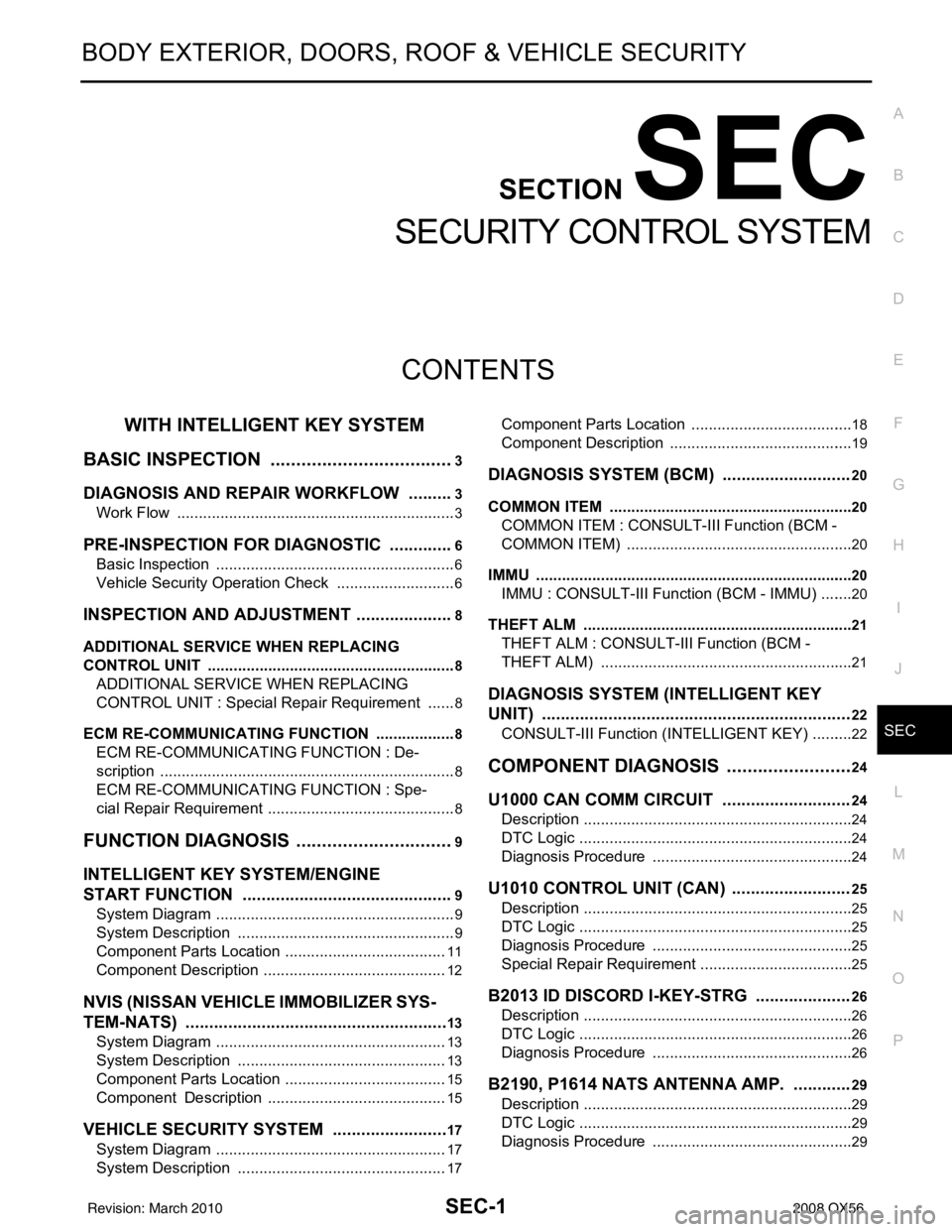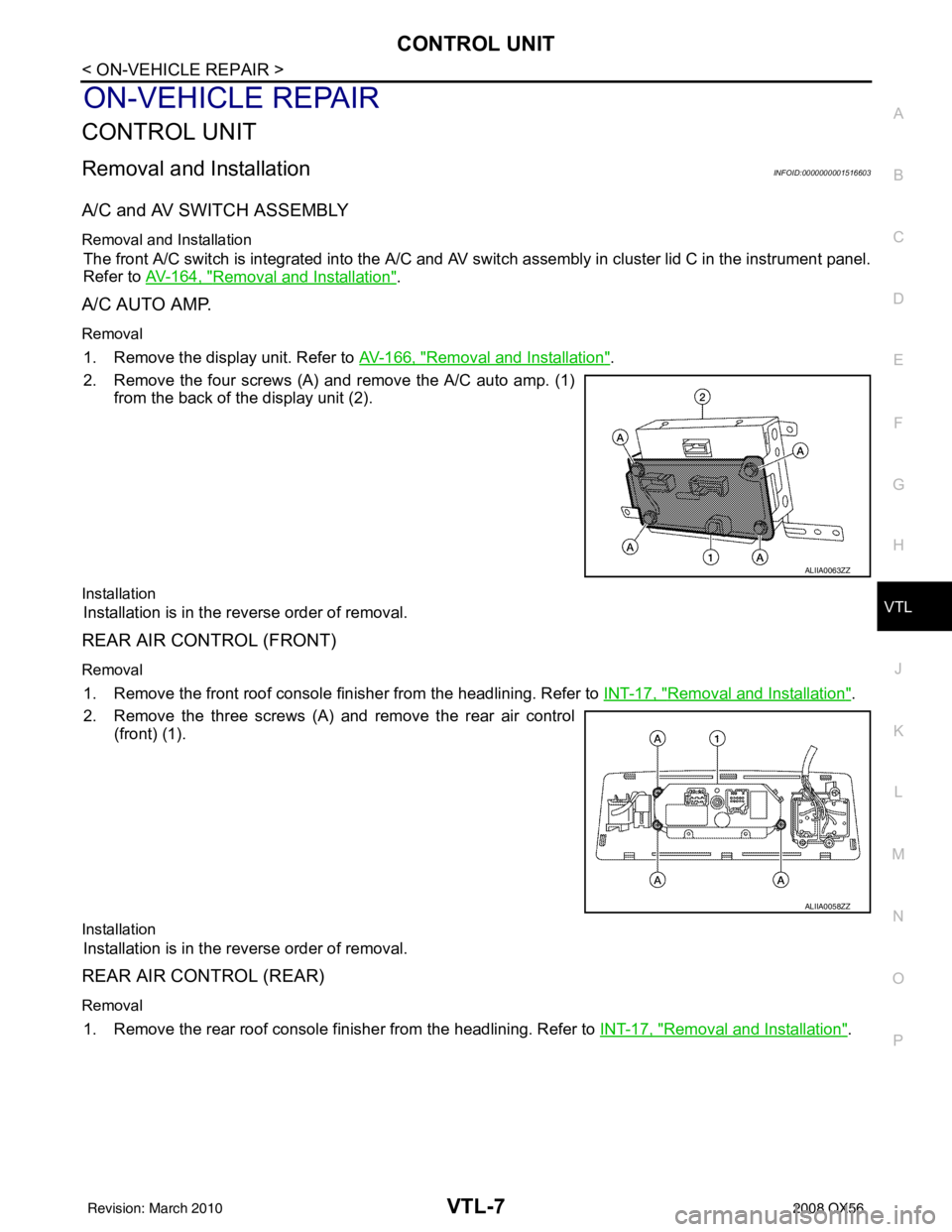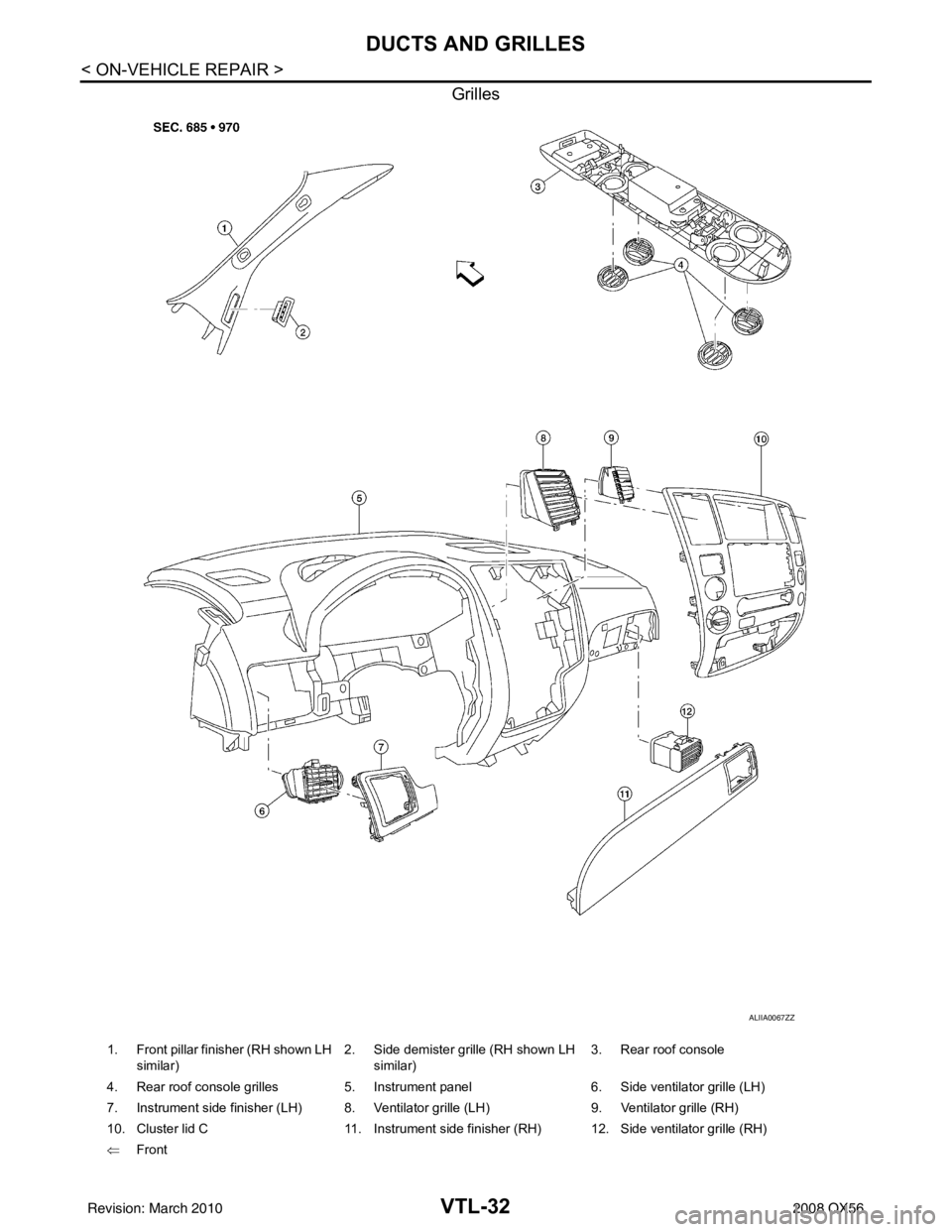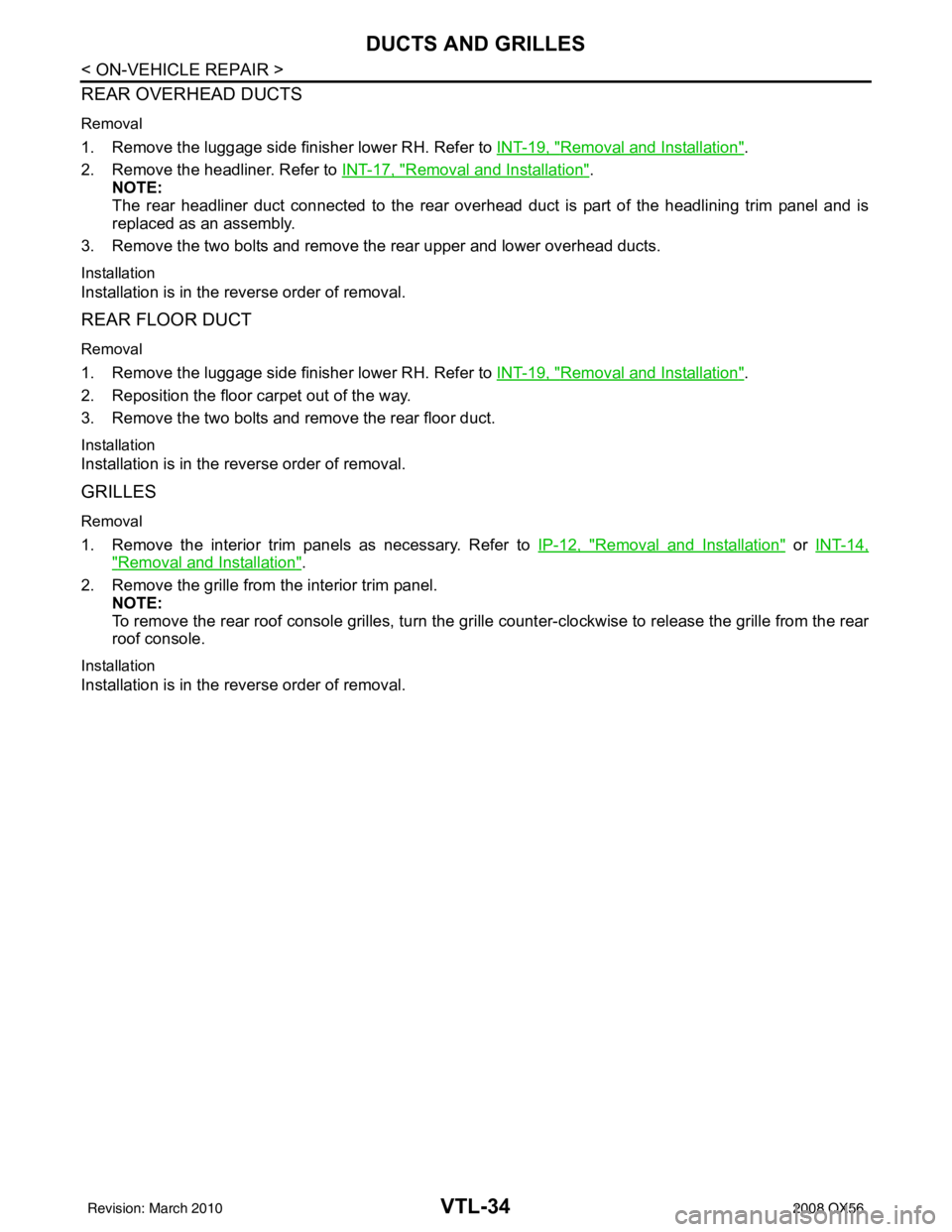2008 INFINITI QX56 roof
[x] Cancel search: roofPage 3162 of 4083

SE-40
< SYMPTOM DIAGNOSIS >
SQUEAK AND RATTLE TROUBLE DIAGNOSES
Most of these incidents can be repaired by adjusting, securing or insulating the item(s) or component(s) caus-
ing the noise.
SUNROOF/HEADLINING
Noises in the sunroof/headlining area c an often be traced to one of the following:
1. Sunroof lid, rail, linkage or seals making a rattle or light knocking noise
2. Sun visor shaft shaking in the holder
3. Front or rear windshield touching headliner and squeaking
Again, pressing on the components to stop the noise while duplicating the conditions can isolate most of these
incidents. Repairs usually consist of insulating with felt cloth tape.
OVERHEAD CONSOLE (FRONT AND REAR)
Overhead console noises are often caused by the c onsole panel clips not being engaged correctly. Most of
these incidents are repaired by pushing up on the c onsole at the clip locations until the clips engage.
In addition look for:
1. Loose harness or harness connectors.
2. Front console map/reading lamp lense loose.
3. Loose screws at console attachment points.
SEATS
When isolating seat noise it's important to note the pos ition the seat is in and the load placed on the seat when
the noise is present. These conditions should be duplicated when verifying and isolating the cause of the
noise.
Cause of seat noise include:
1. Headrest rods and holder
2. A squeak between the seat pad cushion and frame
3. The rear seatback lock and bracket
These noises can be isolated by moving or pressing on the suspected components while duplicating the con-
ditions under which the noise occurs. Most of thes e incidents can be repaired by repositioning the component
or applying urethane tape to the contact area.
UNDERHOOD
Some interior noise may be caused by components under the hood or on the engine wall. The noise is then
transmitted into the passenger compartment.
Causes of transmitted underhood noise include:
1. Any component mounted to the engine wall
2. Components that pass through the engine wall
3. Engine wall mounts and connectors
4. Loose radiator mounting pins
5. Hood bumpers out of adjustment
6. Hood striker out of adjustment
These noises can be difficult to isolate since they cannot be reached from the interior of the vehicle. The best
method is to secure, move or insulate one component at a time and test drive the \
vehicle. Also, engine RPM
or load can be changed to isolate the noise. Repairs can usually be made by moving, adjusting, securing, or
insulating the component causing the noise.
Revision: March 2010 2008 QX56
Page 3209 of 4083

SEC-1
BODY EXTERIOR, DOORS, ROOF & VEHICLE SECURITY
C
DE
F
G H
I
J
L
M
SECTION SEC
A
B
SEC
N
O P
CONTENTS
SECURITY CONTROL SYSTEM
WITH INTELLIGENT KEY SYSTEM
BASIC INSPECTION ....... .............................
3
DIAGNOSIS AND REPAIR WORKFLOW ..... .....3
Work Flow ........................................................... ......3
PRE-INSPECTION FOR DIAGNOSTIC ..............6
Basic Inspection .................................................. ......6
Vehicle Security Operation Check ............................6
INSPECTION AND ADJUSTMENT .....................8
ADDITIONAL SERVICE WHEN REPLACING
CONTROL UNIT .................................................... ......
8
ADDITIONAL SERVICE WHEN REPLACING
CONTROL UNIT : Special Repair Requirement .......
8
ECM RE-COMMUNICATING FUNCTION ............. ......8
ECM RE-COMMUNICATING FUNCTION : De-
scription .....................................................................
8
ECM RE-COMMUNICATING FUNCTION : Spe-
cial Repair Requirement ............................................
8
FUNCTION DIAGNOSIS ...............................9
INTELLIGENT KEY SYSTEM/ENGINE
START FUNCTIO N ........................................ .....
9
System Diagram .................................................. ......9
System Description ...................................................9
Component Parts Location ......................................11
Component Description ...........................................12
NVIS (NISSAN VEHICLE IMMOBILIZER SYS-
TEM-NATS) ........................................................
13
System Diagram .................................................. ....13
System Description .................................................13
Component Parts Location ......................................15
Component Description ..........................................15
VEHICLE SECURITY SYSTEM .........................17
System Diagram .................................................. ....17
System Description .................................................17
Component Parts Location .................................. ....18
Component Description ...........................................19
DIAGNOSIS SYSTEM (BCM) ...........................20
COMMON ITEM ..................................................... ....20
COMMON ITEM : CONSULT-III Function (BCM -
COMMON ITEM) .....................................................
20
IMMU ...................................................................... ....20
IMMU : CONSULT-III Function (BCM - IMMU) ........20
THEFT ALM ........................................................... ....21
THEFT ALM : CONSULT-III Function (BCM -
THEFT ALM) ....................................................... ....
21
DIAGNOSIS SYSTEM (INTELLIGENT KEY
UNIT) .................................................................
22
CONSULT-III Function (INTELLIGENT KEY) ..........22
COMPONENT DIAGNOSIS .........................24
U1000 CAN COMM CIRCUIT ...........................24
Description ........................................................... ....24
DTC Logic ................................................................24
Diagnosis Procedure ...............................................24
U1010 CONTROL UNIT (CAN) .........................25
Description ...............................................................25
DTC Logic ................................................................25
Diagnosis Procedure ...............................................25
Special Repair Requirement ....................................25
B2013 ID DISCORD I-KEY-STRG ....................26
Description ...............................................................26
DTC Logic ................................................................26
Diagnosis Procedure ...............................................26
B2190, P1614 NATS ANTENNA AMP. ............29
Description ...............................................................29
DTC Logic ................................................................29
Diagnosis Procedure ...............................................29
Revision: March 2010 2008 QX56
Page 3847 of 4083

CONTROL UNITVTL-7
< ON-VEHICLE REPAIR >
C
DE
F
G H
J
K L
M A
B
VTL
N
O P
ON-VEHICLE REPAIR
CONTROL UNIT
Removal and InstallationINFOID:0000000001516603
A/C and AV SWITCH ASSEMBLY
Removal and Installation
The front A/C switch is integrated into the A/C and AV swit ch assembly in cluster lid C in the instrument panel.
Refer to AV-164, "
Removal and Installation".
A/C AUTO AMP.
Removal
1. Remove the display unit. Refer to AV-166, "Removal and Installation".
2. Remove the four screws (A) and remove the A/C auto amp. (1) from the back of the display unit (2).
Installation
Installation is in the reverse order of removal.
REAR AIR CONTROL (FRONT)
Removal
1. Remove the front roof console finisher from the headlining. Refer to INT-17, "Removal and Installation".
2. Remove the three screws (A) and remove the rear air control (front) (1).
Installation
Installation is in the reverse order of removal.
REAR AIR CONTROL (REAR)
Removal
1. Remove the rear roof console finisher from the headlining. Refer to INT-17, "Removal and Installation".
ALIIA0063ZZ
ALIIA0058ZZ
Revision: March 2010 2008 QX56
Page 3872 of 4083

VTL-32
< ON-VEHICLE REPAIR >
DUCTS AND GRILLES
Grilles
ALIIA0067ZZ
1. Front pillar finisher (RH shown LH similar) 2. Side demister grille (RH shown LH
similar) 3. Rear roof console
4. Rear roof console grilles 5. Instrument panel 6. Side ventilator grille (LH)
7. Instrument side finisher (LH) 8. Ventilator grille (LH) 9. Ventilator grille (RH)
10. Cluster lid C 11. Instrument side finisher (RH) 12. Side ventilator grille (RH)
⇐ Front
Revision: March 2010 2008 QX56
Page 3874 of 4083

VTL-34
< ON-VEHICLE REPAIR >
DUCTS AND GRILLES
REAR OVERHEAD DUCTS
Removal
1. Remove the luggage side finisher lower RH. Refer to INT-19, "Removal and Installation".
2. Remove the headliner. Refer to INT-17, "
Removal and Installation".
NOTE:
The rear headliner duct connected to the rear overhead duct is part of the headlining trim panel and is
replaced as an assembly.
3. Remove the two bolts and remove the rear upper and lower overhead ducts.
Installation
Installation is in the reverse order of removal.
REAR FLOOR DUCT
Removal
1. Remove the luggage side finisher lower RH. Refer to INT-19, "Removal and Installation".
2. Reposition the floor carpet out of the way.
3. Remove the two bolts and remove the rear floor duct.
Installation
Installation is in the reverse order of removal.
GRILLES
Removal
1. Remove the interior trim panels as necessary. Refer to IP-12, "Removal and Installation" or INT-14,
"Removal and Installation".
2. Remove the grille from the interior trim panel. NOTE:
To remove the rear roof console grilles, turn the gr ille counter-clockwise to release the grille from the rear
roof console.
Installation
Installation is in the reverse order of removal.
Revision: March 2010 2008 QX56